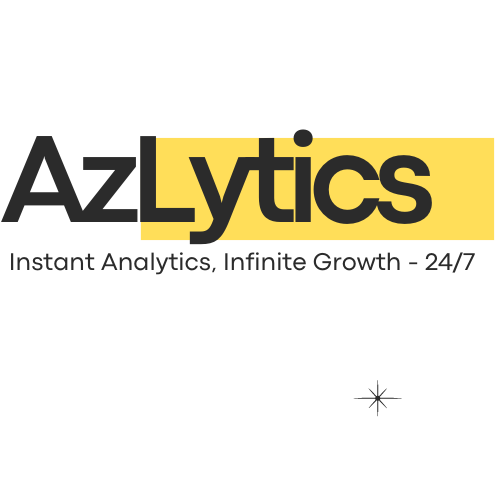How to Effortlessly Link eBay to Shopify and Boost Your Sales [2024]
Introduction: Why Linking eBay to Shopify is a Game-Changer
Running an online store feels like juggling too many plates sometimes, doesn’t it? eBay and Shopify are great on their own, but what if you could connect them and run everything seamlessly from one place? Sounds like a dream, right?
eBay is home to millions of shoppers, while Shopify gives you the control to build a brand and a loyal customer base. Combine these two platforms, and you’ve got yourself a recipe for success. In 2024, linking eBay to Shopify is easier than ever. It’s a win-win for sellers looking to streamline their business and boost sales.
In this guide, we’ll show you how to connect the two, step-by-step, with tools like Nembol and data-driven insights from AzLytics. Get ready to optimize your workflow, save time, and (most importantly) watch your profits grow.
Shopify vs. eBay: The Best of Both Worlds
Imagine Shopify as your own custom-built store—it’s got your branding, your style, and a personal touch that makes it feel unique. You’re in control of everything from product displays to the checkout experience. That’s Shopify for you.
Now, eBay? That’s like the bustling marketplace with tons of foot traffic. People are always browsing for deals, and it’s a lot easier to get noticed. The only downside? There are plenty of competitors also vying for attention.
But here’s the kicker: why settle for just one? By linking eBay to Shopify, you tap into eBay’s massive audience while maintaining full control over your brand on Shopify. It’s like having the best of both worlds—high traffic and a personalized shopping experience.
Selling on eBay: Pros and Cons
Selling on eBay has its perks, but it’s not without a few challenges. Let’s break it down:
Pros:
- Massive audience: 135 million active buyers from around the globe. That’s a lot of eyes on your products.
- No marketing hassle: You don’t have to hunt for customers—they’re already browsing the site.
- Quick setup: You can be up and selling in no time.
Cons:
- Crowded market: Standing out can be tricky with so many sellers.
- Seller fees: eBay takes a cut of your sales, so it’s not free.
- Limited branding options: You’re stuck with eBay’s design, so your store might not have that personal touch.
Why You Should Use Shopify for eCommerce
If eBay is the crowded marketplace, Shopify is your own boutique. Shopify gives you full control over the look and feel of your store. Want to adjust the product layout or tweak the branding? No problem. Here’s why Shopify works so well for growing businesses:
- Brand control: Customize your store to match your vision—right down to the last pixel.
- Customer loyalty: A personalized shopping experience means buyers are more likely to come back.
- Data control: With Shopify, you’ve got access to valuable customer insights and analytics. This helps you make smarter business decisions.
At the end of the day, while eBay helps you get more visibility, Shopify is where you build deeper connections with your customers.
Why Sell on Both eBay and Shopify?
Selling on both platforms isn’t just a good idea—it’s a brilliant one. Why? Because you’ll be covering all your bases. Here’s what you get when you link eBay to Shopify:
- Double the customers: Some people love eBay for its bargains, while others prefer the personalized feel of a Shopify store.
- A smoother funnel: Direct eBay shoppers to your Shopify store for an even better experience.
- One-stop management: Sync your products, inventory, and orders across both platforms. No more bouncing between dashboards.
How to Link eBay to Shopify in 4 Simple Steps
Ready to connect eBay to Shopify? Here’s how to get it done in just four easy steps using Nembol.
Step 1: Connect Your Shopify and eBay Accounts
- Log into Nembol and select “Channels.”
- Click the “Connect channels” button, then choose Shopify and eBay.
- Authorize the connection, and Nembol will handle the rest.
It’s that simple—Nembol does all the heavy lifting so you don’t have to.
Step 2: Import Your Products from eBay
- Adjust your eBay settings in Nembol.
- Click “Get your products” to import all your eBay listings.
- Wait a few seconds, and refresh the product page to see your listings in Shopify.
Step 3: Bulk List Products to Shopify
- Choose the Shopify collection where you want your eBay products to appear.
- Select the products you want to publish (you can list up to 500 at once).
- Hit “Publish,” and just like that, your products are live on Shopify!
Step 4: Sync Inventory and Orders
With the integration complete, it’s time to activate inventory and order sync. Nembol makes sure your stock levels and sales are updated across both platforms, so you’ll never oversell or run out of stock.
Syncing Your Shopify and eBay Inventory
Managing inventory across two platforms can be a headache if you’re doing it manually. Thankfully, Nembol has you covered with real-time inventory sync. Here’s how to set it up:
- Go to Nembol’s Settings tab.
- Toggle on “Quantity Sync” for both eBay and Shopify.
- Watch as your inventory syncs automatically between the two platforms.
Pro Tip: Sell internationally? Use Nembol’s Price Sync feature to handle currency conversions without breaking a sweat.
Importing eBay Orders into Shopify
One of the best things about Nembol is that it lets you handle all your orders in one place. No more flipping between platforms. Here’s how to set it up:
- Go into Nembol’s settings and enable Order Sync.
- Configure how you want unpaid or unlinked products to be handled.
- Nembol automatically imports eBay orders into Shopify, so you can manage everything from one dashboard.
Common Issues with Linking eBay to Shopify (and How to Fix Them)
1. Inventory Discrepancies
Issue: Your stock levels aren’t the same on both platforms.
Solution: Make sure inventory sync is enabled for both Shopify and eBay in Nembol. Think of it like trying to bake a cake without turning on the oven—you can’t expect it to work without setting up the basics!
2. Unlinked Products
Issue: Some products aren’t linking correctly.
Solution: Use Nembol’s auto-link feature, or manually link products by matching SKUs. It’s a bit of detective work, but once the mystery’s solved, everything syncs smoothly.
3. Price Mismatch
Issue: Prices on eBay don’t match Shopify.
Solution: Enable Price Sync to make sure your prices stay consistent. No one likes surprise price tags, whether they’re shopping in-store or online!
Final Thoughts: Boost Your Sales with Shopify and eBay in 2024
Connecting eBay and Shopify in 2024 is a smart move if you’re looking to streamline your operations and grow your business. With one-click integration, synced inventory, and a single dashboard to manage your orders, you’ll have more time to focus on what really matters—scaling your business.
Don’t forget, tools like AzLytics can help you analyze your performance across platforms and fine-tune your strategy. Let 2024 be the year your multi channel business really takes off!
FAQs:
- How do I avoid overselling when linking eBay to Shopify?
Activate inventory sync in Nembol to automatically update stock levels across both platforms. - Will linking eBay to Shopify change my eBay fees?
No, your eBay fees stay the same, but you’ll save time by managing everything in one place. - Can I sync international prices between eBay and Shopify?
Absolutely. Nembol’s Price Sync feature allows you to adjust prices automatically based on currency. - What happens if a product sells out on Shopify but not on eBay?
Nembol’s real-time sync will automatically update eBay to mark it as sold out. - Is there a limit to how many products I can sync?
Nembol lets you bulk upload up to 500 products at a time, so managing a large inventory is a breeze.




